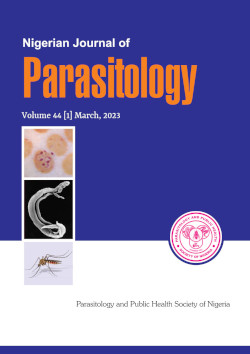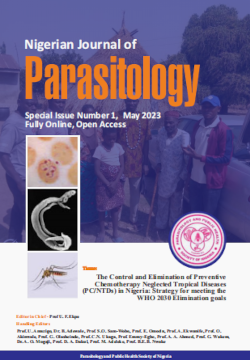Prevalence of Giardia lamblia Infection among Pupils and Students from Selected Schools in Nsukka Metropolis, Enugu State
https://dx.doi.org/10.4314/njpar.v44i1.26
Keywords:
public health, Nsukka, parasite, infection, Giardia lambliaAbstract
Globally, Giardia lamblia is the most common intestinal protozoa parasite with about 200 million yearly infections inAfrica, Asia, and Latin America. The parasite is common in third-world countries with poor living conditions. The current surge in terrorism across Nigeria has forced people to migrate into relatively peaceful regions and Nsukka has been one of the cities in Nigeria that have witnessed the influx of migrants. This migration aids the spread of G. lamblia and thus puts the public health of the inhabitants of Nsukka metropolis at risk. The current state of G. lamblia infection in Nsukka metropolis is not known and this knowledge gap hampers effective planning by public health officers and policymakers to safeguard the public health of the inhabitants. The objectives of this study were to provide information on the prevalence of G. lamblia infection among pupils and students from selected schools within Nsukka metropolis and to provide data on the age group that is more vulnerable to the parasitic infection among the studied population for public health campaign against the parasite. Faecal samples were collected from 170 individuals from five different schools. The faecal samples were examined for G. lamblia under the microscope using formol-ether concentration and direct smear methods. The prevalence of G. lamblia is 38.2% The prevalence is higher in males (40.3%) than in females (36.7%). El-Shaddai Nursery and Primary School (ENPS) and University of Nigeria Nsukka (UNN) recorded the highest prevalence of 53.3% each. Children in the age groups 3 - 7 years had the highest prevalence of 66.7%. Giardia lamblia is widespread among children and university students in Nsukka metropolis.
References
Garba, C. M. G. and Mbofung, C. M. F. (2010). Relationship Between Malnutrition and Parasitic Infection among School
Children in the Adamawa Region of Cameroon. Pakistan Journal of Nutrition 9 (11): 1094-1099
Nkrumah, B. and Nguah, S. B. (2011). Giardia lamblia: a major parasitic cause of childhood diarrhoea in patients attending a district hospital in Ghana. Parasites and Vectors 4:163
Tigabu, A., Taye, S., Aynalem, M. and Adane, K. (2019). Prevalence and associated factors of intestinal parasitic infections among patients attending Shahura Health Center, Northwest Ethiopia. BMC Research Notes12(333): https://doi.org/10.1186/s13104-019-4377-y
Mohammed, M. A. K., Lim, Y. A., Surin, J., Wan, K. L. and Al-Mekhlafi, M. S. (2008). Risk factors for endemic giardiasis: highlighting the possible association of contaminated water and food. Transactions of the Royal Society of Tropical Medicine and Hygiene 102 (5): 465-470.
Samie, A., Tanih, N. F., Seisa, I., Seheri, M., Mphahlele, J., ElBakri, A. and Mbati, P. (2020). Prevalence and genetic characterization of Giardia lamblia in relation to diarrhea in Limpopo and Gauteng provinces, South Africa. Parasite Epidemiology and Control 9:e00140
Espelage, W., an der Heiden, M., Stark, K. and Alpers, K. (2010). Characteristics and risk factors for symptomatic Giardia lamblia infections in Germany. BMC Public Health 10: 41
Carmena, D., Guillermo, A. C. and Sanchez-Serrona, L. P. (2012). Current situation of Giardia infection in Spain; Implications for Public Health World. Journal of Clinical Infectious Disease 2(1): 1-12.
Quihui-Cota, L., Morales-Figueroa, G. G., Javalera-Duarte, A., Ponce-Martínez, J. A., Valbuena-Gregorio, E. and LópezMata, M. A. (2017). Prevalence and associated risk factors for Giardia and Cryptosporidium infections among children of northwest Mexico: a cross-sectional
study. BMC Public Health 17: 852
Siwila, J., Mwaba, F., Chidumay, N. and Mubanga, C. (2020). Food and waterborne protozoan parasites: The African Perspective. Food and Waterborne Parasitology 20:e00088 https://doi.org/10.1016/j.fawpar.2020.e00088
Grit, G. H., Bénére, E., Ehsan, A., De Wilde, N., Claerebout, E., Vercruysse, J., Maes, L. and Geurden, T. (2012). Giardia duodenalis cyst survival in cattle slurry. Veterinary Parasitology 12; 184: 330 - 334
Afolabi, O. J., Simon-Oke, I. A. and Bakare, P. T. (2016). The Prevalence of Intestinal Parasites among Students in Federal University of Technology Akure, Nigeria. International Journal of Tropical Disease and Health 14(2): 1-9.
Hajare, S. T., Chekol, Y. and Chauhan, N. M. (2022). Assessment of prevalence of Giardia lamblia infection and its associated factors among government elementary school children from Sidama zone, SNNPR, Ethiopia. PLoS One 17(3):e0264812. doi: 10.1371/journal.pone.0264812.
Hajissa, K., Islam, M. A., Sanyang, A. M. and Mohamed, Z. (2022). Prevalence of intestinal protozoan parasites among school children in Africa: A systematic review and meta-analysis. PLoS Neglected Tropical Diseases 16(2): e0009971.
Anim-Baidoo, I., Narh, C. A., Oddei, D., Brown, C. A., Enweronu-Laryea, C., Bandoh, B., Sampane-Donkor, E.,Armah, G., Adjei, A. A., Adjei, D. N., Ayeh-Kumi, P. F. and Gyan, B. A. (2016). Giardia lamblia infections in children in Ghana. Pan African Medical Journal 24:217
Berrouch, S., Escotte-Binet, S., Amraouza, Y., Flori, P., Aubert, D., Villena, I. and Hafid, J. (2020). Cryptosporidium spp., Giardia duodenalis
and Toxoplasma gondii detection in fresh vegetables consumed in Marrakech, Morocco. African Health Science 20(4):1669-1678.
Halliez, M. C. and Buret, A. G. (2013). Extra-intestinal and long-term consequences of Giardia duodenalis infections. World Journal of Gastroenterology 19(47): 8974- 8985. doi: 10.3748/wjg.v19.i47.8974.
Oguoma, V., Anyasodor, A. and Mbata, T. (2008). Prevalence of intestinal protozoan parasites among children aged 5-12 years in Owerri Metropolis South-eastern Nigeria. Tropical Journal of Health Sciences 15(2): 43-48.
Obiukwu, M. O., Onyido,A. E., Obianika, S. C. and Ezeh. S. N. (2008). Prevalence of Giardia lamblia cyst; its detection in water bodies and relationship with environmental factors in Abagana, eastern Nigeria. Nigerian Journal of Parasitology 29(2): 147–151.
Biu, A., Bintu, I. and Agbadu, E. T. (2009). Prevalence of giardiasis among out-patients of the University of Maiduguri Teaching Hospital, Nigeria. International Journal of Biomedical and Health Sciences 5(4):171- 174
Nyamngee, A., Kolawole, O. M., Durowade, K. A. and Kolawole, C. F. (2009). Prevalence of giardiasis among children in Guma refugee camp in Guma LGA, Benue State, Nigeria. SMJ 6(1): 32-39
Inabo, H. I., Ya’u, B. and Yakubu, S. E. (2011). Asymptomatic Giardiasis and Nutritional Status of Children in Two Local GovernmentAreas in Kaduna State, Nigeria. Sierra Leone Journal of Biomedical Research 3(3): 157-162.
Ogbuu, O., Ohaeri, C. C., Amaechi, E. C. and Ejike, B. U. (2018). Giardiasis and its Associated Risk Factors Among School Children in Selected Rural Communities in South-eastern Nigeria. Manila Journal of Science 11: 12-21.
Obianagwa, C. E., Ifem, L. A., Uwaechia, O. G., Borlin, E.M., Ejiofor, C. C., Ereforokuma, O. N. and Anene, J. I. (2022). Open defecation in Nsukka Local Government Area of Enugu State, Nigeria: shifting the discussion towards health and socio-economic implications. Global
Journal of Arts Humanity and Social Sciences 2(12): 918 – 928.
NPC (2006). The Nigeria Population Census, National Population Commission, Abuja.http://www.population.gov.ng/index. php/censuses.
Cheesbrough, M. (2010). District Laboratory Practice in Tropical Countries. Part 2, 2nd Edition, Cambridge University Press Publication, SouthAfrica, 1-434.
Arora, D.R. andArora, B.B. (2010). Medical Parasitology. 3rd Edition.
Haq, K.A. U., Gul, N.A., Hammad, H. M., Bibi, Y., Bibi, A. and Mohsan, J. (2015). Prevalence of Giardia intestinalis and Hymenolepis nana in Afghan refugee population of Mianwali district, Pakistan. African Health Sciences 15(2): 394-400
Adams, V. J., Markus, M. B., Adams, J. F. A., Jordaan, E., Curtis, B., Dhansay, M. A., Obihara, C. C. and Fincham, J. E. (2005). Paradoxical helminthiasis and giardiasis in Cape Town, South Africa: epidemiology and control. African Health Sciences 5(2): 131-136
Choy, S. H., Al-Mekhlafi, H. M., Mahdy, M. A. K., Nasr, N. N., Sulaiman, M., Lim, Y. A. L. and Surin, J. (2014). Prevalence and Associated Risk Factors of Giardia Infection among Indigenous Communities in Rural Malaysia. Scientific Reports 4: 6909
Julio, C., Vilares, A., Oleastro, M., Ferreira, I., Gomes, S., Monteiro, L., Nunes, B., Tenreiro, R. and Ângelo, H. (2012). Prevalence and risk factors for Giardia duodenalis infection among children: A case study in Portugal. Parasites Vectors 5:22 https://doi.org/10.1186/1756-3305-5-22
El Basha, N. R., Zaki, M. M., Hassanin, O. M., Rehan, M. K. and Omran, D. (2016). Giardia assemblages A and B in diarrheic patients: a comparative study in Egyptian children and adults. Journal of Parasitology102(1): 69–74. https://doi.org/10.1645/14-676
Downloads
Published
How to Cite
Issue
Section
License
Copyright (c) 2023 Nigerian Journal of Parasitology

This work is licensed under a Creative Commons Attribution-NonCommercial-NoDerivatives 4.0 International License.





